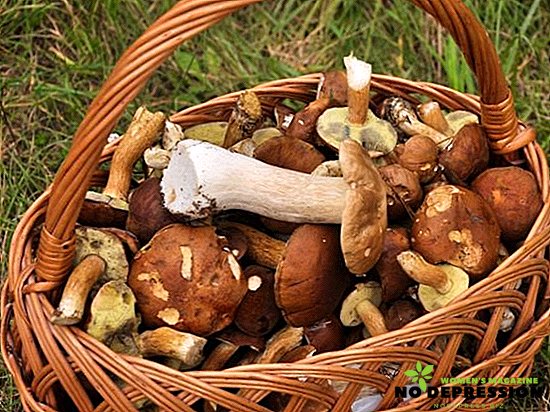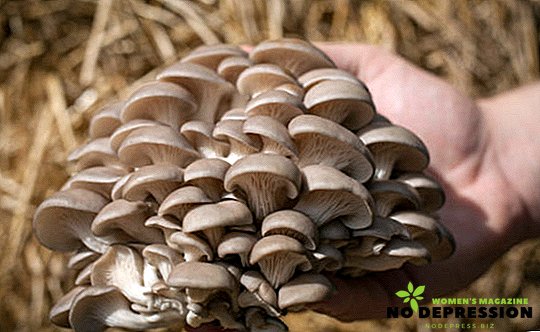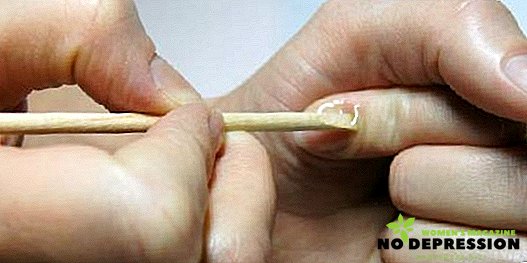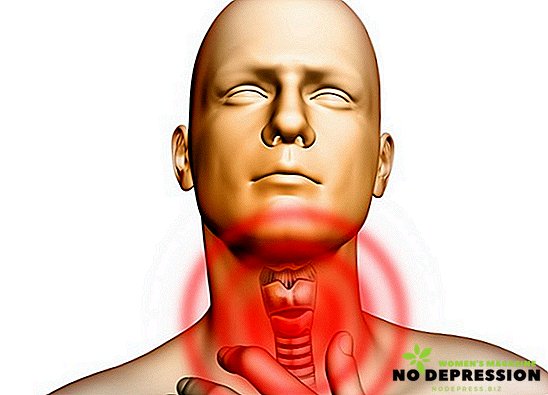Mushroom poisoning can be fatal if you do not provide first aid in time. However, you need to know the main symptoms of mushroom poisoning. This will help to recognize the trouble and immediately call the ambulance crew.

Main symptoms of mushroom poisoning
The signs of this state are quite different - it all depends on what kind of fungus you ate and in what quantity. But there are also a number of common symptoms:
- abdominal pain, which may have varying degrees of severity;
- constant nausea and vomiting, and the latter can not be stopped and it does not bring any relief;
- stools can be up to 20 times per day.
Indomitable vomiting and constant diarrhea often become causes of dehydration, as a result, patients die before the hospital stage, especially if seeking medical help was untimely
The manifestation of symptoms depends only on what kind of toxin entered the body, that is, what kind of poisonous mushrooms were consumed.
Phalloidin
This toxin enters the body through the use of pale toadstools, smelly mushroom. The tissues of these fungi contain phalloidin - it has a damaging effect on the liver cells literally 2-3 minutes after ingestion. At the same time, the first symptoms of mushroom poisoning appear only after 8-20 hours, in some cases on the second day.
Symptoms of phalloidin poisoning include:
- intense abdominal pain;
- heavy sweating;
- persistent vomiting and diarrhea;
- lowering body temperature.
It is worth noting that the poisoning with this toxin is considered one of the most severe, so the victim develops very quickly renal and hepatic failure. Coma and death can occur in the absence of proper treatment.
Poisoning with this toxin in 70% of cases is fatal. Treatment is possible with timely diagnosis before the onset of pronounced symptoms, but even if the patient is still alive, he may experience severe pathologies of the kidneys and liver.
Orelanin
This toxin is contained in a mountain spider web, a reddish umbrella. The intake of this toxin in the body is considered deadly, but the main problem is that its effect on the internal organs and systems is hidden for a long time, because the first symptoms appear several days or weeks after the use of poisonous mushrooms.
The main signs of poisoning include:
 unquenchable thirst;
unquenchable thirst;- intense headaches;
- pain in the kidneys and abdomen;
- feeling cold in the lower or upper extremities.
Most often, the death of the victim is associated with acute renal failure, which is developing rapidly and is not amenable to restraining therapy.
However, such poisoning is rarely diagnosed, since such fungi rarely enter the basket to the mushroom picker.
Poisoning red toadstools
Such mushrooms have a distinctive feature - in case of poisoning, the toxin, which is contained in the composition, affects the central nervous system. As a result, the victim develops visual, tactile hallucinations, delusions and hysteria appear.
Another difference in poisoning with such mushrooms is that the digestive system is affected first, with the result that the first symptoms will be:
- vomiting and diarrhea;
- excessive sweating;
- slow heartbeat;
- severe abdominal pain.
When toxins enter the body, the work of the gastrointestinal tract is disturbed at first, and only then the central nervous system. Due to the rapid manifestation of symptoms, the patient is most often provided with timely medical assistance.
It consists in the complete washing of the stomach, intestines. Then the doctors inject drugs that support and stabilize the work of the heart and central nervous system.
Muscarin
This toxin is found in the mushroom, but always in combination with other toxins. However, there are mushrooms in which it is contained in its pure form, for example, in fiber, govorushkah. Symptoms of ingress of poison into the body begin to appear after two hours:
- bradycardia;
- vomiting, nausea, diarrhea;
- slight constriction of the pupils.
It should be noted that if the poisoning with this toxin occurs in a severe form, then pulmonary edema begins to develop in the victim, due to which there is a severe respiratory failure.
Gel Velvet Mushrooms
These are morels and stitches. Many consider them conditionally edible, but experts categorically prohibit consuming them for food, since in this case it is necessary to know the peculiarities of their preparation in order not to be mistaken. The main symptoms of poisoning include:
- jaundice;
- a sharp increase in hemoglobin in the blood;
- drowsiness;
- diarrhea and vomiting.
Hallucinogenic mushrooms
Many believe that only the fly agaric has a hallucinogenic effect, but in fact there are much more such mushrooms. The most famous is psilocybe mushroom. But in appearance they do not even resemble edible ones, so rarely does a mushroom picker pick up their basket.
Nevertheless, the following symptoms of poisoning with hallucinogenic fungi are known to medicine:
- pressure drop;
- extension icons;
- feeling intoxicated;
- fatigue and sleepiness.
If the victim does not have the necessary medical care, then the symptoms proceed more clearly: severe psychosis with hallucinations, a distorted view of what is happening.
Manure poisoning
Dung beetle belongs to the type of conditionally edible mushrooms, it can be eaten. But it has its toxic effect if it is used together with alcohol (or if it is consumed after 2 hours).
There is an opinion that this toxin does not dissolve in water, but in alcoholic beverages - yes, after which it quickly spreads throughout the body. The main symptoms include:
- red complexion;
- anxiety state;
- slow pulse;
- pain in the intestines.
Poisoning the digestive tract
Such poisoning can occur, including with the consumption of conditionally edible mushrooms, if heat treatment was incorrectly carried out or an incorrect storage method was chosen.
Symptoms for this type of poisoning occur several hours after eating foods:
- vomiting and nausea;
- diarrhea;
- temperature rise;
- convulsions and loss of consciousness.
Most often, these symptoms are present for several days.
How to give first aid to the victim?
When the first symptoms of poisoning appear, you should immediately call a doctor. The remains of the mushrooms are set aside for further research, which will make it possible to determine as quickly as possible the type of poison and prescribe the correct therapy.
And before the doctor arrives, the victim should be given first aid consisting of the following measures:
- flush the stomach using at least one and a half liters of water;
- to provoke vomiting, press the root of the tongue with a spoon (pregnant women should not vomit);
- in the absence of diarrhea, give one tablespoon of castor oil;
- let the patient take any sorbent, such as activated carbon;

- provide plenty of drink: water, black strong tea, mineral water;
- put the patient in bed, at the feet attach a warm heating pad.
Inpatient treatment
In case of poisoning the patient is placed in the toxicology department. Therapy is as follows:
- Wash the stomach with a probe.
- Assign salt laxative, forced diuresis, intravenous administration of solutions.
- On the first day hemosorption is carried out, that is, the purification of blood from toxins.
- Prescribed therapy for cardiovascular and renal failure.
- If a person is poisoned with a red fly agaric, an antidote is administered in individually selected doses.
Undoubtedly, it is possible to reduce the amount of toxins due to the digestion of the collected mushrooms in slightly acidified water, but the risk of poisoning still remains
What are the consequences of poisoning?
The consequences of mushroom poisoning, especially if proper therapy was not prescribed, are very serious:
- When poisoning with pale toadstool death occurs in 80% of cases.
- When poisoning amanita mortality reaches 50%.
- When severe poisoning is destroyed, the liver and kidneys stop working, which requires either transplantation of these organs, or leads to death.
The main cause of mushroom poisoning is ignorance of distinctive signs, disregard of the rules of prevention. Remember that some fungal poisons affect all organs and systems, can cause death in a few days. The inability to provide first aid, the delay in calling an ambulance is also often the cause of death of the victim.
Why can be poisoned with edible mushrooms?
The main problem of edible mushrooms is bacteria that have not evaporated or died during cooking. In addition, there are fungi that accumulate harmful substances from the soil and air. An important role is played by the gathering place.
Types of edible mushrooms that can be poisoned:
- Champignon. Champignon intoxication affects the gastrointestinal tract: vomiting, pain in the stomach. These are the first signs of poisoning. Therefore, follow all treatment rules and be sure to consult a doctor.

- Honey agaric. The main problem is that they absorb harmful substances, heavy metals from the earth. The first symptoms of poisoning come in a few hours. Metals leads to nausea, vomiting, indigestion. To recover, you must cleanse the body of harmful impurities.
- Oyster mushrooms. Despite the fact that it is a safe and edible mushroom, negative consequences can occur when improperly grown. Oyster mushroom intoxication is similar to common eating disorders.

- Lines. To protect these mushrooms, you need to cook them for a long time or fry. It’s forbidden to use them in their raw form, because it can end in death. The main symptoms that occur during the day are: diarrhea, vomiting, abdominal pain. Later, if the correct treatment was not started, the balance in the liver and kidneys is disturbed, after which the toxins pass to the central nervous system.
Prevention
In order not to poison mushrooms, follow a few rules:
- Take only the mushrooms you know. If there is the slightest doubt, you drop them and do not allow them to share in the same basket with the already collected product.
- Do not pick old wormy mushrooms, do not taste them raw.
- Before you take a mushroom, examine it, paying attention to the color of the cap, the presence of plates.
- Collect in the basket, not in the package.
- Do not store mushrooms for a long time - cook them immediately.
- Any products before cooking must be boiled, and pour the broth.
- Mushroom canned food is not recommended to cook at home.


 unquenchable thirst;
unquenchable thirst;












